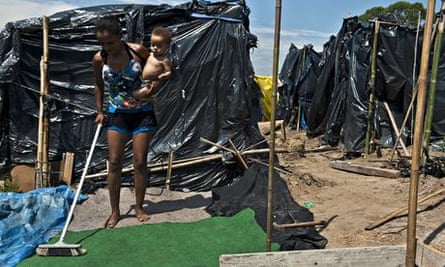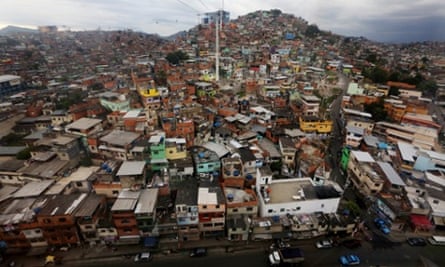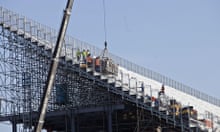The narrow, gated entrance to the derelict tile factory on Avenida Itaoca provides few clues to the astonishing hub of activity within. But take just a few steps across the threshold and you find yourself in the midst of Rio de Janeiro's newest sanctuary for the poor.
Filling every inch of floorspace, alley, roof and yard, more than a thousand refugees from the city's gentrified favelas have been building a community here, plank by plank, nail by nail, for the past two months since the "occupation" of the factory began.
A constant stream of residents now wander into the Tufi Community – as it has been named – with scavenged lumber, plywood and tarpaulin, which is quickly hammered and pinned to form doorways, walls and roofs. But this is a DIY social project in more ways than one. With no support from the government and suspicion from many of the public, the residents have little alternative but to help themselves.
Almost everyone here is from Alemão, a favela complex that has started to move upmarket since it was "pacified" by police in 2010. Rent rises are now pushing out the poor who were struggling on the fringes of the favela.
Unable to make ends meet, the first few hundred families among them moved en masse into the abandoned factory in March, rapidly followed by more than a thousand more. The first arrivals are the lucky ones – with a leaky roof over their heads and four shared toilets. The latecomers have to make do with a steep slope behind the building, which floods with mud during rainstorms.
"We live in total poverty," said Marianne Christina da Silva, the secretary of the residents' association. "There is no sewage, no drinking water and very few people have electricity. But people moved here because they had to choose whether their children would eat or whether they would have a home."

This is a much repeated story in Rio, a resort city that has long been home both to the super-rich and the migrant poor, who move into slums that are then developed as soon as the land becomes valuable, often forcing them into homelessness or the occupation of derelict buildings or unused land. The trend has been given a shot of adrenalin by the World Cup and Olympics, which are pushing up property prices and accelerating government efforts to reclaim the slums and relocate poor communities despite the risk of adding to a dire homeless problem.
The Tufi Community is one of many mass squats in Brazil's biggest cities that have been set up by those who complain they have been priced out of their homes. Occasionally, this results in violent evictions. In March, riot police used teargas to clear a nascent community of several thousand people from a factory owned by the Oi telecoms company. The displaced residents have since moved to three other locations and vented their frustration by burning public buses and a police car.
This week, a thousand homeless families in São Paulo reportedly moved into a site just two miles from the opening venue of the World Cup. They were bussed to the site by the Landless Workers' Movement, which says the occupation aims to highlight the failure of government promises to improve social housing.
At Tufi, too, residents contrast the government's cosmetic efforts to make the city presentable for World Cup visitors and its negligence in dealing with long-term housing problems.

"The government wants to have a lovely World Cup and for the city to look nice, yet we still see children sleeping in the street. How nice is that?" said Da Silva, of the residents' association, which helps to allocate space in the building and settle issues about noise and rotas for using the toilets and kitchen.
With dwellings separated only by the thickness of plywood or tarpaulin, there are inevitably tensions in the crowded factory, but the mood is upbeat. Children play happily in the narrow make-shift corridors, the toilets are impressively clean, there is a chapel, and some budding entrepreneurs have opened bars and beauty salons.
"Look, you can see a community being formed in front of your eyes," said Carolos Henrique Oliveira, who guided the Guardian through the building.
It is divided into numbered sectors, which are spray-painted on to the walls so that residents have an address. Isaac Cruise and his family share one of the better spaces. There are no windows and little space, but he has electricity for a TV and DVD player, and has decorated the walls with art.
"I like this place. It really shows what people can do even without proper homes," he says. "But I don't want to stay. This is not a permanent solution. We need something like this while we wait for the government to provide something permanent."
It could be a long wait. The national government has invested heavily in social housing, which is one of the centrepieces of its poverty alleviation policies. But after building 3m homes for lower income families over the past five years, the Minha Casa, Minha Vida (My Home, My Life) programme is on hold before the presidential election in October.
Meanwhile, the situation for the homeless continues to be dire. Estimates of the scale of the problem vary wildly. The NGO Moradores do Rua estimates that up to 1.8 million people live on the street, or 0.9% of the population. Official estimates put the numbers far lower. Rio, which is believed to have the worst homeless situation, has only 5,580 street dwellers, according to a recent city study.
Meanwhile, rents and property prices continue to rise, putting more pressure on the poor and adding to the incentives for further occupations of Rio's numerous empty buildings. Having grabbed their small plots, Tifi residents are preparing for a long stay.
The president of the community association, Carlos Alberto, said: "We want help from the government to lead a dignified life, but if there is no help coming, we'll manage here by ourselves."
Additional reporting: Sam Cowie







Comments (…)
Sign in or create your Guardian account to join the discussion